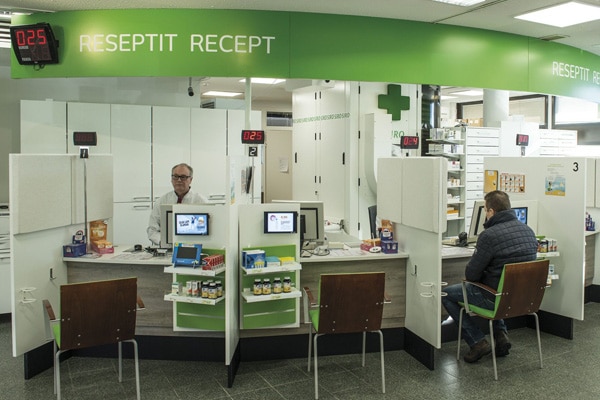Finnish company Capps Oy has developed an automated storage system for pharmacies that is based on completely new thinking. The machine takes only a fraction of the space of traditional storage but can hold many more products.
A pharmacy is a health-care service provider
“The pharmacy business has changed dramatically during the last decade,” says Hans Fock, apothecary of Sipoo Pharmacy, near Helsinki in Finland. “The proceeds from sales of medicines and their profit margins have inevitably decreased simultaneously, forcing pharmacies to increase the efficiency of their operation and decrease expenses. At the same time, however, we retain our important traditional role of guiding and educating our clients.” Prescription medicines account for the lion’s share of a pharmacy’s turnover, there are thousands of brands and hundreds of prescription are filled every day. Controlling and automating medical logistics is vital for a pharmacy’s efficiency. The flawless delivery of medicines is also crucial.

Automated storage is on its way
About 100 of Finland’s 700 - 800 pharmacies already use pharmacy robots. The traditional method of storing medicines in sets of drawers is very laborious. Incoming products have to be put in their correct place, production dates must be managed, and regular stocktaking is necessary. Careful collection of the products for the customer is essential to ensure that no mistakes are made. Moreover, the more usual drawer-storage system takes up considerable space.
In the Sipoo Pharmacy the storage robot had been in operation for about ten years. In traditional automated storage a small industrial robot moves on rails inside a large cabinet. It pushes the products in diagonally rising ‘channels’ at both sides of the rails. Each product has its own location. The channels are almost always only partially filled, and packages brought in first will always remain there unless the channels are emptied completely or rearranged.
Capps offered Sipoo an alternative robotic system that has been created using a new set of principles.
“Our old robot took a 2 x 6 m² space from floor to ceiling,” explains Fock. “In terms of the space it took it was not much better than drawers, though it did reduce our work. We had occasional problems but we learned to live with them. Capps offered us a machine that only required 2 x 2 m² and had 40 per cent more storage capacity – so we were interested immediately.”

A combination of machine vision and innovation
“Our target was very compact automated storage with high capacity, designed to fit any pharmacy,” says Ilpo Hakkarainen, founding partner of Capps Oy. “An automatic system whose size and price would be suitable for anybody. I think we have succeeded very well.”
The Cappsel robot has tens of round and rotating shelves with a diameter of about two meters, one upon the other. The total surface of the shelves is almost one hundred square meters. A robot arm takes the packages fed to it, measures their dimensions, and places them in the smallest space possible on its shelves. The arm, its rotating gripper and rotating shelves form an entirety in which packages are placed in parallel, with an average distance of 2.5 millimeters from one other. Wasted space is minimal.
“When we receive a package we read its barcode and the robot remembers the location of every package on the shelves,” continues Hakkarainen. “When a pharmacist places an order, the robot picks the oldest package of the requested type and places it in the delivery gutter. The products have no fixed locations in the storage system so the whole shelf area can be utilised completely. The distance between the shelves varies, of course, to provide space for larger packages.”
A large number of intelligent sensors
The Cappsel robot has a lot of mechanics, six servo-driven shafts, one DC-driven shaft, and a compressor. The device sensing is accomplished in a way that makes the robot as reliable as possible. There are about 30 sensors, most of which are supplied by SICK.
“SICK has participated in our development work from the beginning,” says Teemu Oittinen, Technical Director at Capps Oy. “We have always sent them concept drawings of various units and discussed how to best implement them in each case. We have got many good ideas from them and we haven’t had to specify sensor types ourselves. Everything is based on confidence in one another and, because SICK has the very best knowledge regarding sensors, this has saved us a lot of time.”
“SICK offers many intelligent I/O-link sensors that have proved very suitable. Besides measuring the specified values, the sensors also collect a lot of additional information that may be used for analyzing machine functions in product development. The sensors can also be programmed externally so if we have to make any modifications we can easily change a sensor’s scanning distance or other parameters using software.”
Of the main sensors employed, Oittinen particularly mentions the OLM barcode encoder and the measuring MLG light grid. Barcodes are located every couple of centimeters (at the edge of each rotating shelf) and these are read with the OLM sensor. The shelves are then rotated to exactly the right position to pick and place packages. The MLG light grid is used for measuring the dimensions of packages when they are taken.

The huge market potential is growing
Capps is a small but international company. The first Cappsel robot was delivered to a customer in November 2016, and five of them were in use in Finland by end of 2017. Growth targets are ambitious. “Prescription medicines in Finland are typically sold in batches of three months or 100 units,” says Fock. “In Central Europe they favour one month or 30 unit batches, so the client visits the pharmacy every month – three times as often as in Finland. This significantly increases the need for machines such as Cappsel. Cappsel also improves security in a pharmacy. A burglar would not find it easy to find a particular item because medicines are stored randomly. The most important advantage, however, is that Cappsel saves space and work. The time Cappsel saves can be spent on taking care of our clients.”


